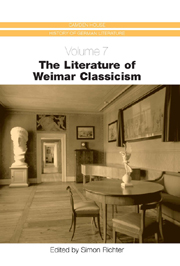Book contents
- Frontmatter
- Contents
- List of Illustrations
- Preface and Acknowledgments
- Conventions, Editions, and Abbreviations
- Introduction
- What is Classicism?
- Antiquity and Weimar Classicism
- The Correspondents' Noncorrespondence: Goethe, Schiller and the Briefwechsel
- Johann Gottfried Herder: The Weimar Classic Back of the (City)Church
- Drama and Theatrical Practice in Weimar Classicism
- German Classical Poetry
- The Novel in Weimar Classicism: Symbolic Form and Symbolic Pregnance
- German Women Writers and Classicism
- Weimar Classicism as Visual Culture
- The Irrelevance of Aesthetics and the De-Theorizing of the Self in “Classical” Weimar
- Goethe's “Classical” Science
- The Political Context of Weimar Classicism
- Bibliography
- Notes on the Contributors
- Index
Weimar Classicism as Visual Culture
Published online by Cambridge University Press: 05 February 2013
- Frontmatter
- Contents
- List of Illustrations
- Preface and Acknowledgments
- Conventions, Editions, and Abbreviations
- Introduction
- What is Classicism?
- Antiquity and Weimar Classicism
- The Correspondents' Noncorrespondence: Goethe, Schiller and the Briefwechsel
- Johann Gottfried Herder: The Weimar Classic Back of the (City)Church
- Drama and Theatrical Practice in Weimar Classicism
- German Classical Poetry
- The Novel in Weimar Classicism: Symbolic Form and Symbolic Pregnance
- German Women Writers and Classicism
- Weimar Classicism as Visual Culture
- The Irrelevance of Aesthetics and the De-Theorizing of the Self in “Classical” Weimar
- Goethe's “Classical” Science
- The Political Context of Weimar Classicism
- Bibliography
- Notes on the Contributors
- Index
Summary
In June 1796, Jean Paul, who had only just become a successful writer with his novel Hesperus (published 1795), visited Weimar. Goethe and Schiller were intrigued at the prospect of meeting him and read his novel in anticipation. Their impression was mixed. The author of the book, wrote Schiller in a letter to Goethe dated 28 June 1796, is “fremd wie einer, der aus dem Mond gefallen ist, voll guten Willens und herzlich geneigt, die Dinge außer sich zu sehen, nur nicht mit dem Organ, mit dem man sieht” (alien, like one who has come from the moon, full of good will and well disposed to see the things besides himself, just not with the organ with which one sees). Jean Paul had no eye for appearances, for perception and visualization; an aptitude for mental reflection predominated. This judgment, which would eventually lead to intense polemical debate, is characteristic of the standard and ideal of art and literature propagated by the two intellectual giants of Weimar. Not that Schiller, the philosopher-poet, who also suffered from a surplus of mental reflection, would apply the same standard to himself. But with Goethe as his example, this evidentiary ideal, this sensuous, sensate configuration of what is comprehensible to the eye, was set as the measure for all aesthetic efforts. Two years earlier, shortly after their first personal acquaintance, Schiller had written to Goethe in an effort to clarify for himself the peculiar nature of Goethe's creative talent.
- Type
- Chapter
- Information
- The Literature of Weimar Classicism , pp. 265 - 294Publisher: Boydell & BrewerPrint publication year: 2005



